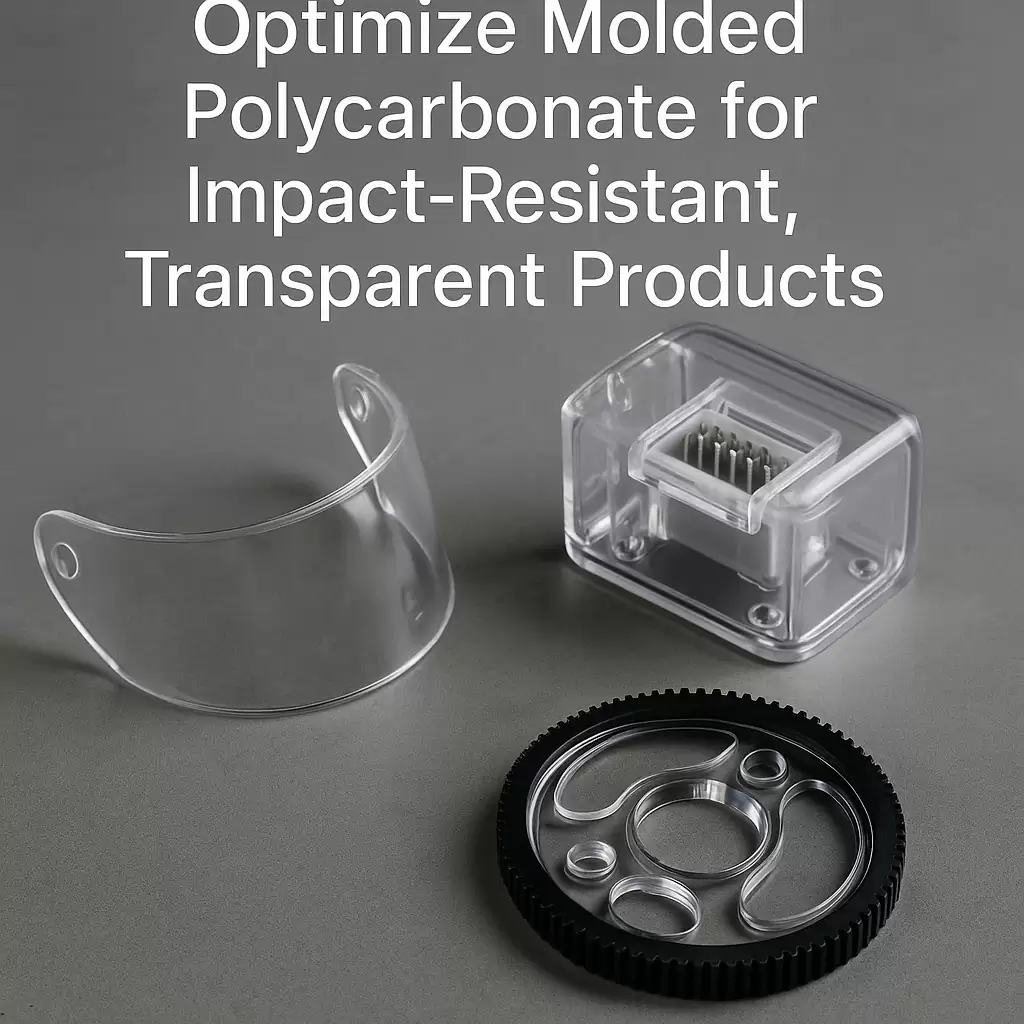Optimize Molded Polycarbonate for Impact-Resistant, Transparent Products
Optimize Molded Polycarbonate for Impact-Resistant, Transparent Products
Few engineering plastics strike the balance of crystal clarity, nearly un-breakable strength, and design freedom like polycarbonate (PC). When executed correctly, molded PC parts outperform glass, PETG, and acrylic in impact energy, dimensional stability, and flame performance—all while slashing weight and assembly cost. Below is a playbook to maximize PC’s advantages, avoid common pitfalls, and launch optical-grade parts at full production speed with help from TaiwanMoldMaker.com.
1 Why Polycarbonate? A Quick Comparison
| Property (Typical) | PC | Acrylic (PMMA) | PETG | Tempered Glass |
|---|---|---|---|---|
| Izod Impact (notched, 23 °C) | 600–850 J/m | 15–25 J/m | 60–90 J/m | 700 J/m (shatters) |
| Light Transmission | 88–90 % | 92 % | 88 % | 90 % |
| Continuous-Use Temp | 115 °C | 80 °C | 70 °C | 200 °C |
| UL 94 Flame Rating | V-0 (with FR grades) | HB | HB | — |
| Typical Wall (optical) | 1.2–4 mm | 2–5 mm | 1–3 mm | ≥ 3 mm (heavy) |
Takeaway: Choose PC when shock loading, flame compliance, or thin-wall optics rule out lower-cost resins.
2 Processing Best Practices for Crystal-Clear, Tough Parts
| Parameter | Recommended Window | Why It Matters |
|---|---|---|
| Resin Drying | 120 °C ± 3 °C for 3–4 h; ≤ 0.02 % moisture | Prevents splay, bubbles, and strength loss |
| Melt Temperature | 260–300 °C | Lower = un-melted pellets; higher = yellowing |
| Mold Temperature | 80–110 °C | Higher temp = better optical clarity & gloss |
| Injection Velocity | High-speed, 90–120 mm/s | “Freezes” knit lines behind the flow front |
| Holding Pressure | 60–90 % of peak; 6–12 s | Reduces sink and birefringence |
| Venting Depth | 0.013 mm (0.0005 in) | Avoids burn marks on high-flow edges |
Tip: For parts thicker than 4 mm, gas-assist or sequential gating minimizes residual stress and cycle time.
3 Design Guidelines to Preserve Impact Strength & Clarity
-
Uniform Wall Thickness: Target 1.5–3 mm; step transitions max 20 % per change.
-
Generous Radii: ≥ 0.5× wall; sharp corners trigger crack initiation.
-
Rib/Boss Ratios: Rib height ≤ 3× wall; thickness ≤ 0.6× to prevent sink.
-
Gate Placement: Tab or fan gates on non-optical edges; hot runners for uniform fill in lenses/guards.
-
Texture vs. Polish: SPI-A2 or diamond polish for viewing windows; VDI 27–30 for non-optical grip zones.
4 Secondary Operations that Unlock Premium Performance
| Operation | Benefit | In-House at TaiwanMoldMaker.com |
|---|---|---|
| Hard-Coat (SiO₂ / UV-cure) | 6–8H pencil hardness, anti-scratch | ✔️ Clean-room spray & UV lines |
| Anti-Fog / Anti-Glare | Eyewear, helmet visors | ✔️ Dip & plasma options |
| Laser or Pad Printing | Permanent icons on housings | ✔️ Class 7 controlled area |
| Vapor Deposition EMI Shield | Smart-device covers | ✔️ Nickel/Cu, ≤ 1 µΩ/sq |
5 Applications That Push PC to the Limit
| Industry | High-Performance PC Parts |
|---|---|
| Medical | Sterilizable oxygen masks, autoinjector windows |
| Automotive | ADAS sensor lenses, LED light guides, panoramic roof shades |
| Consumer Electronics | Smartphone backplates, VR headset optics |
| Safety & Security | Riot shields, bullet-resistant glazing laminates |
| Industrial IoT | Explosion-proof enclosure windows, machine-vision covers |
All can leverage flame-retardant, UV-stable, or glass-fiber-reinforced PC grades when mechanical or regulatory requirements dictate.
6 Validation & Compliance Checklist
-
ISO 10993 / USP VI for skin-contact devices
-
UL 94 V-0 / 5VA for electronics housings
-
FMVSS 302 & ISO 3795 for interior auto parts
-
REACH & RoHS statement of compliance for EU import
TaiwanMoldMaker.com maintains material COAs and supports first-article FTIR plus haze/transmittance testing—ready for your technical file or FDA 510(k).
7 TaiwanMoldMaker.com—Your Fast-Track PC Partner
| Challenge | Integrated Solution |
|---|---|
| Optical-grade polish & gating | Diamond-polish cavity inserts + hot-runner valve gates |
| Stress-free thick sections | Gas-assist + Moldflow® warp simulation in 48 h |
| UL & medical documentation | Resins traceable to lot; DHR & DMR packages ready |
| Cycle-time & energy targets | Conformal-cooled cores + all-electric presses (≤ 0.45 kWh/kg) |
Quick-Link Services
8 Next Steps—Turn CAD into Crystal-Clear Reality
-
Upload your 3-D files & performance targets (impact, clarity, flame).
-
Receive a 48-hour Polycarbonate DFM Pack—gate plan, Moldflow, and cost model.
-
Approve dual-path tooling (Al bridge + steel production).
-
Get first-article PC parts in as little as three weeks, complete with optical & impact test data.
When clarity, toughness, and speed all matter, optimized polycarbonate molding is the decision that pays. Partner with TaiwanMoldMaker.com and combine Tier-1 process control, optical-grade tooling, and in-house finishing to launch impact-resistant, transparent products—fast.









